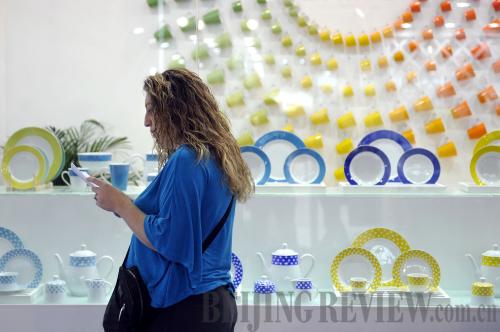|
 |
|
COLORFUL DISPLAY: A customer walks past ceramic products at the Canton Fair on April 23 (LIANG XU) |
"If foreign enterprises show interest in our products, they would contact us after the fair and go to visit our factory and research center, rather than paying a deposit on the spot like those in the past," said Gu.
In other words, people are more cautious with placing orders. "But that doesn't necessarily mean fewer orders are being signed at the fair, for potential orders will come when the fair is wrapped up. This year, I believe there may be a 10-percent increase in potential orders," added Gu.
Export trading
According to data from the Ministry of Commerce, China's first-quarter foreign trade was valued at 6.12 trillion yuan ($990.2 billion), up 13.4 percent year-on-year. Exports for the period were 3.2 trillion yuan ($507.9 billion), an 18.4 percent year-on-year increase, while imports grew 8.4 percent to 2.9 trillion yuan ($460.3 billion) for the first three months.
A poll of 1,900 foreign-trade enterprises nationwide by the ministry showed that orders received by exporters have rebounded, and that exporting confidence is also recovering, with 38.7 percent of these enterprises reporting an increase in the value of their export orders in March.
"The outlook for exports for the whole year may not be so optimistic due to changing foreign demand, the rising cost of raw materials and fierce market competition," Ministry of Commerce spokesman Shen Danyang said. With increasing demand from emerging markets, including the Middle East, South America, Russia and Southeast Asia, China's foreign trade will continue to steadily increase this year, according to Liu.
At the same time, the EU still needs time for a steady recovery and Japan's economy has just begun to show signs of a recovery. "We saw a surge in orders from countries like Southeast Asia, Central and South America and the Middle East, while orders from European countries and the United States have leveled off," said Gu.
On the opening day of the fair, the middle rate of the Renminbi against the dollar again reached a new high—6.2506. According to a survey by Economic Information Daily, the constantly rising exchange rate has imposed pressure on small private enterprises, who have limited bargaining power in trading. Statistics showed that in the first quarter of this year, the exchange rate of the Renminbi against the dollar rose 0.36 percent from the end of 2012.
"As the exchange rate of Renminbi has soared from over 8 to less than 6.2 in the past six years, we face rising production costs by enhancing quality and technical added value, but the pressure is still looming," said Gu.
Operating cost for domestic businesses is still floating at a high level, and the price of labor power has been on the rise. Since the beginning of this year, a total of 13 provinces and cities have lifted their minimum wage rates at an average increase of 16.9 percent.
"A major difficulty we are facing is recruiting workers," said Wen Zhiman, who worked in the marketing department at Guangdong Shine Electric Appliances Co. Ltd., a small private enterprise that also attended the fair.
Products from neighboring countries have gradually gained international competitiveness and eroded the market share of Chinese enterprises in overseas market, which is evident in developed markets like Japan and the EU.
All the above-mentioned obstacles, along with external factors like increasing trade protectionism, re-industrialization in developed economies and strengthening competition in labor-intensive industries from neighboring countries, will continue to haunt Chinese exporters.
Email us at: dengyaqing@bjreview.com | 